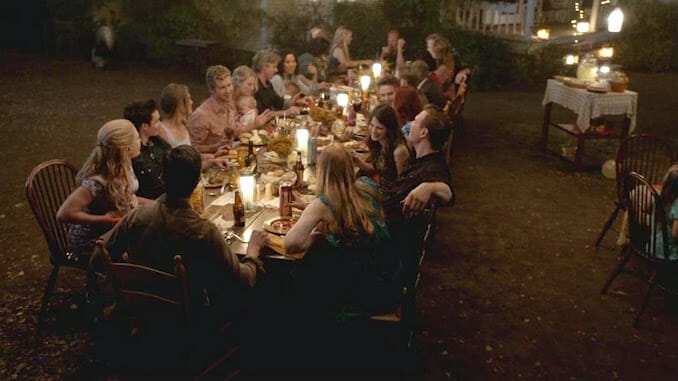It Still Stings: True Blood‘s Trash Ending Didn’t Have to Be This Way
Photo Courtesy of HBO
Editor’s Note: TV moves on, but we haven’t. In our feature series It Still Stings, we relive emotional TV moments that we just can’t get over. You know the ones, where months, years, or even decades later, it still provokes a reaction? We’re here for you. We rant because we love. Or, once loved. And obviously, when discussing finales in particular, there will be spoilers:
![]()
While it’s true that HBO’s vampire drama True Blood was never going to be for everyone, it’s hard to deny that the show was a great time, one that arrived precisely when the pop culture zeitgeist needed it. A blood-soaked Southern Gothic romp with a bite both literal and metaphorical, True Blood was everything the Twilight franchise wasn’t, in all the best ways.
From its diverse array of supernatural beings—not content to just be a story about vampires, True Blood also featured telepaths, witches, shapeshifters, faeries, and an assortment of were-creatures—to its insistence on casting its blood-drinkers as stand-ins for various sociological metaphors (“God Hates Fangs!”), this was a show that delighted in pushing boundaries and embracing its campiest tendencies. And that’s before you got to all the excessive gore and plentiful sex. Throw in a cast of extremely attractive people, a lot of gratuitous nudity, and some genuinely shocking—and often extremely violent—twists, and… well. It’s not exactly a surprise that its first few seasons were both critical and cultural hits.
Loosely based on Charlaine Harris’s popular Southern Vampire Mysteries series of novels, True Blood follows the story of Sookie Stackhouse (Anna Paquin), a telepathic waitress in the small town of Bon Temps, Louisiana. She falls in love with a two-hundred-year-old vampire named Bill Compton (Stephen Moyer) and is drawn into the darker side of the supernatural, from grisly murders to the bizarre world of vampire politics. Over the course of its seven seasons, we meet a variety of other colorful characters, including vampire sheriff Eric Northman (Alexander Skarsgård), werewolf packmaster Alcide Herveaux (Joseph Manganiello), the uber-campy vampire king of Mississippi, Russell Edgington (Denis O’Hare), and spiritual medium Lafayette Reynolds (Nelsan Ellis). There’s also Sookie’s best friend Tara Thornton (Rutina Wesley), her dumb but hot brother Jason (Ryan Kwanten), and her boss, the shape-shifter Sam Merlotte (Sam Trammell).
Most of these people (with blood relatives, gay men, and 3,000-year-old vampire royalty excepted) eventually express some sort of sexual interest in Sookie because that’s just the kind of show this is. And that complete soapy ridiculousness is part of the reason True Blood was such entertaining television, and why the dull slog of its final season was so darn disappointing. It’s doubtful that any viewer that stuck around thought it was going to be high art. But it’s equally unlikely that anyone could have predicted just how utterly bland and unambitious it would be.
Maybe True Blood’s spiral into abject awfulness was inevitable. Few series make it to seven seasons at all, and fewer still are worth watching when they get there. But no matter how you feel about the show—whether you loved it, hated it, or simply abandoned ship back when one of the series’ main characters was resurrected as a vampire god (I wish I was kidding!!)—I think we can all agree that it deserved better than its ending. Because True Blood’s finale (“Thank You”) not only gleefully spat on most of the things the viewers who were still around cared about, but committed the cardinal sin of not even being fun to watch in the process.
-

-

-

-

-

-

-

-

-

-

-

-

-

-

-

-

-

-

-

-

-

-

-

-

-

-

-

-

-

-

-

-

-

-

-

-

-

-

-

-








































